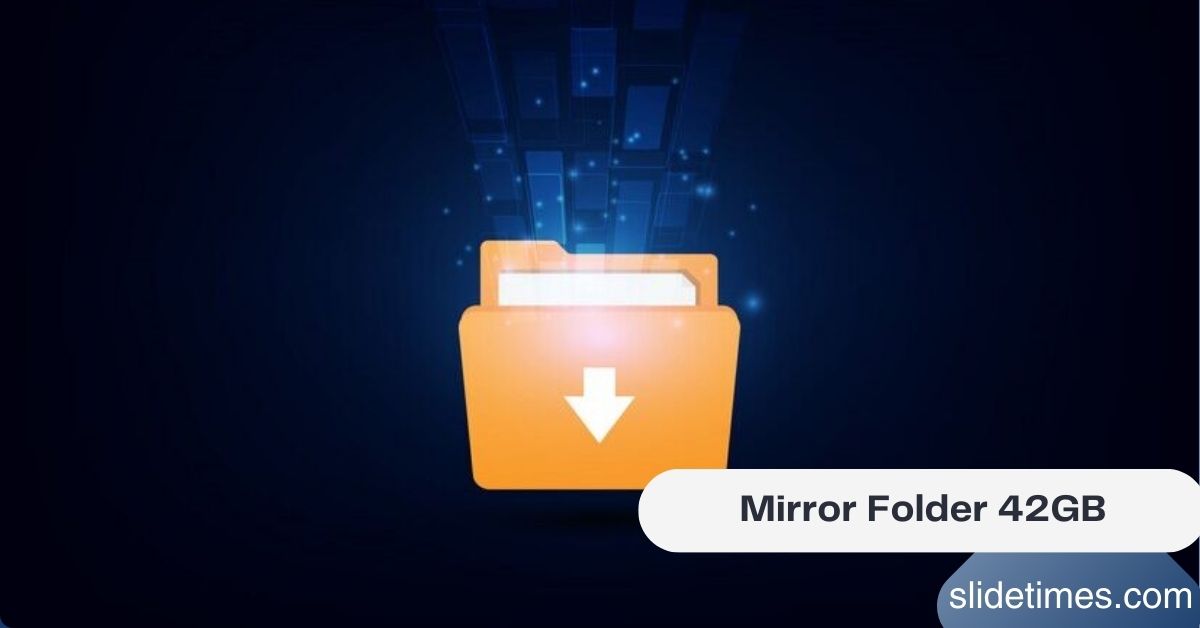In today’s digital age, managing and safeguarding large amounts of data is crucial. One effective method is using a mirror folder, especially when dealing with substantial data sizes like 42GB. This guide will explain what a mirror folder is, its benefits, challenges, and how to set one up, all in simple terms.
What Is a Mirror Folder?
A mirror folder is an exact copy of a folder where all files are duplicated and kept the same across two locations. Whenever you add, delete, or change a file in the original folder, the same happens in the mirror folder automatically. It’s like having a twin of your folder that always stays updated.
For example, if you have a folder named “Photos” on your computer and set up a mirror folder on an external hard drive, any new photo you add or edit in the “Photos” folder will reflect in the mirror folder instantly.

Key Features of a Mirror Folder:
- Automatic Syncing: Ensures that any changes in the original folder are reflected in the mirror folder.
- Real-time Updates: Some tools provide real-time updates, while others sync at scheduled intervals.
- Backup and Recovery: Acts as a safety net in case of accidental deletions or data corruption.
Why Use a Mirror Folder for 42GB of Data?
Handling large data, such as 42GB, can be challenging. Here’s why using a mirror folder is beneficial:
1. Data Backup and Security
By mirroring your folder, you create a backup. If your computer crashes or files get corrupted, the mirror folder serves as a safety net, ensuring you don’t lose important data. Instead of relying on a single storage location, you have a duplicate that prevents total data loss.
Example Scenario:
- A photographer storing high-resolution images in a 42GB folder can use a mirror folder to prevent data loss in case of a hard drive failure.
2. Syncing Across Devices
If you use multiple devices, a mirror folder ensures all your files are up-to-date everywhere. For instance, working on a project on your desktop and laptop becomes seamless when both have access to the same mirrored data.
Also Read: 5StarsStocks.com Nickel: A Deep Dive into Its Value, Impact, and Future Trends
Example Scenario:
- A graphic designer working on a project on both their home PC and office laptop can ensure all updates reflect instantly on both devices.
3. Efficient Collaboration
For team projects, a mirror folder allows all members to access the latest files. Any changes made by one person are reflected for everyone, enhancing collaboration. This is particularly useful in shared environments where multiple users need access to the same files.
Example Scenario:
- A marketing team working on a 42GB folder containing videos, graphics, and documents can sync changes instantly without manual file transfers.
Challenges of Using Mirror Folders
While mirror folders are helpful, there are some challenges to consider:
1. Storage Space
Mirroring a 42GB folder means you need an additional 42GB of storage space for the mirror folder. Ensure you have enough space on your backup device or cloud storage. If your device lacks storage, consider using external drives or cloud-based solutions.
2. Syncing Speed
The initial synchronization of a large folder can take time, especially with slower internet connections or older hardware. Subsequent updates are usually faster, but it’s something to keep in mind. If your internet speed is slow, you might experience delays in updating files.
3. Potential Errors
If not set up correctly, mirror folders can face issues like incomplete syncing or file conflicts. It’s essential to monitor the process, especially during the initial setup. Some common issues include:
- Files not syncing due to permission errors.
- Conflicts between different versions of the same file.
- Unexpected deletions if sync settings are incorrect.
How to Set Up a Mirror Folder
Setting up a mirror folder can be straightforward. Here’s a simple guide:
Also Read: Amazon Inventory Management byHyperzon: The Ultimate Guide
1. Choose a Method
Decide whether you want to use built-in operating system features, third-party software, or cloud services.
- Local Mirroring: Uses external drives or secondary partitions.
- Network Mirroring: Utilizes a shared network drive.
- Cloud Mirroring: Syncs files to cloud storage for remote access.
2. Select the Original and Mirror Locations
Identify the folder you want to mirror and choose a destination for the mirror folder, such as an external hard drive, network location, or cloud storage.
3. Configure Sync Settings
Set up the synchronization to ensure that any changes in the original folder reflect in the mirror folder. This can often be set to occur in real-time or at scheduled intervals.
4. Monitor the Process
Especially during the first synchronization, keep an eye on the process to ensure all files are copied correctly. Use built-in logs or sync history options to track any errors or skipped files.
Tools for Creating Mirror Folders
Several tools can help you set up mirror folders:
1. Built-in Operating System Features
- Windows: Use the built-in File History feature to back up files to an external drive.
- macOS: Utilize Time Machine to back up your data to an external drive.
2. Third-Party Software
- SyncBack: A user-friendly tool that allows for detailed synchronization settings.
- FreeFileSync: An open-source tool that helps synchronize files between folders.
3. Cloud Services
- Google Drive: Offers folder synchronization across devices.
- Dropbox: Provides real-time file syncing and backup.
Best Practices for Using Mirror Folders
To make the most out of mirror folders, consider the following tips:
1. Regularly Check Sync Status
Ensure that the synchronization process is running smoothly and all files are up-to-date.
2. Keep Software Updated
If you’re using third-party tools, keep them updated to benefit from the latest features and security patches.
3. Test Your Backups
Occasionally, try restoring files from your mirror folder to ensure the backup works correctly.
Also Read: IGBT Passivation: A Complete Guide to Protection and Performance
Conclusion
A mirror folder is a valuable tool for managing and safeguarding large amounts of data, like a 42GB folder. It provides an extra layer of security, ensures your files are accessible across devices, and facilitates efficient collaboration. By understanding the benefits and challenges and following best practices, you can effectively implement mirror folders in your data management strategy.
FAQs about Mirror Folder 42GB
What happens if I delete a file in the original folder?
If you delete a file in the original folder, it will also be deleted in the mirror folder during the next synchronization.
Can I mirror a folder to multiple locations?
Yes, you can set up multiple mirror folders in different locations, such as an external hard drive and a cloud service.
Is there a limit to the size of the folder I can mirror?
The main limitation is the available storage space in the destination location. Ensure you have enough space to accommodate the mirrored folder.
Do mirror folders work in real-time?
Many tools offer real-time synchronization, but some may update at scheduled intervals. Check your tool’s settings to configure this.
Are mirror folders secure?
Mirror folders are as secure as the locations they are stored in. For sensitive data, consider encrypting your backups and using secure storage solutions.
